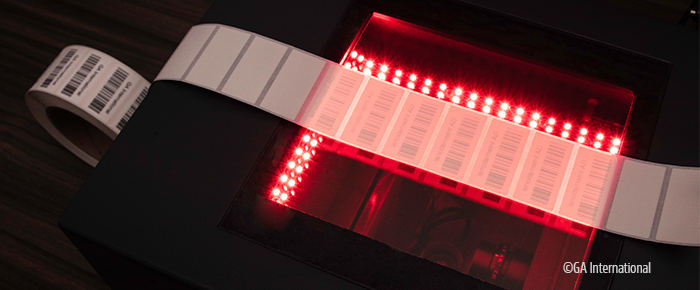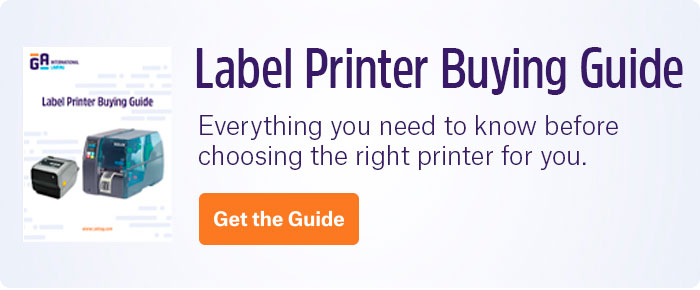
Updated in 2016, the international standard for barcode quality ensures that barcodes used by manufacturers and their customers meet rigorous testing criteria. So, how is barcode grading performed and quality assessed?
How are barcodes graded?
Barcode quality is graded based on many parameters, depending on whether it’s a 1D or 2D barcode:1
|
1D only |
Edge determination |
Refers to how the scanner’s laser perceives the edge of the barcode (where the lines end and the spaces begin). |
|
Minimum reflectance |
Indicates the objective darkness of the bars. The darkest bar in the barcode should have a reflectance of less than half of the background. |
|
|
Decodability |
Measures how close the scan reflectance profile is to failing the “decode” parameter. |
|
|
Minimum edge contrast |
Measures the contrast between adjacent bars and spaces. |
|
|
Defects |
The most apparent change in darkness within a bar or space. |
|
|
1D & 2D |
Quiet zone (white space) |
The amount of space to the left and right of the barcode. |
|
Symbol contrast |
A measure of the contrast between the brightest space on the barcode and the darkest bar. |
|
|
Modulation |
A measure of the local variations in contrast. |
|
|
Decode |
This refers to the ability of the scanner to decode the information present on the barcode based on the sequence of the bars and spaces. |
|
|
2D only |
Reflectance margin |
This indicates how distinguishable the elements of the symbol are. A poor reflectance margin may result in an element being incorrectly designated as dark or light. |
|
Fixed pattern damage |
The quality of the squares and dots around the perimeter as well as the quiet zone. |
|
|
Axial non-uniformity |
Refers to the incorrect scaling of the barcode. |
|
|
Grid non-uniformity |
Assesses the most significant deviation from the grid. |
|
|
Unused error correction |
Computes the amount of error correction required to reconstruct lost data due to poor printing or damage. The less error correction used, the better the grade. |
|
|
Cell contrast |
A form of symbol contrast used for direct parts marking (DPM) barcodes. |
|
|
Cell modulation |
A form of modulation used for DPM barcodes. |
Each parameter is graded numerically on a scale of 0 to 4 or with a letter grade of A, B, C, D, or F, with F representing failed barcode verification.2
For 1D barcodes, the first three parameters tested are minimum reflectance, decode, and minimum edge contrast. If all three receive a passing grade, the software will then test the other parameters. Once every scan has been graded, the average of all scans will constitute the final grade of the barcode. For 2D barcodes, the grading begins by performing a pass/fail test on whether it can be decoded; other parameters are then tested if it receives a passing grade.
Common causes of unreadable barcodes
There are several reasons why a barcode scanning might fail the grading process, including high barcode density, quiet zone violations, print inconsistency, and damage. Encoding too much information on a small barcode can cause it to fail verification; while a barcode with too much data will likely still be scannable, it is recommended to either increase the print size of the barcode or reduce the amount of encoded information. Providing insufficient space for the quiet zone surrounding the barcode can also be problematic, though easily resolved by simply increasing the space reserved for it. Additionally, variations in printing can result in poor readability. Ensure all printing equipment is regularly inspected to guarantee that high-quality, consistent barcodes are generated. Finally, any damage to the barcode will potentially render it impossible to scan. This cannot always be prevented, but using high-quality labels, varnishes, and laminations can protect labels—as well as barcodes—from damage.
What industries require barcode grading?
Pharmaceutical and biotechnology companies rely on validated barcodes (i.e., those that have passed verification) to track their products. In 2015, the US Food and Drug Administration (FDA) began enforcing the Drug Supply Chain Security Act (DSCSA), which requires the use of electronic systems to track prescription drugs as they are distributed throughout the United States. Currently, all products need to be barcoded with a National Drug Code (NDC), serial number, lot number, and expiration date. These barcodes must meet the standards set by the GS1 or Health Industry Business Communications Council (HIBCC). GS1 standards recommend using the 2D ISO/IEC Data Matrix symbology, and all barcodes must have a minimum grade of 1.5 or C, though many distributors require a grade of 3 or higher.3,4 Medical devices also require barcoded labels encoding their unique device identifier (UDI), a code that identifies each individual device sold, with barcode grading requirements similar to those of FDA-regulated pharmaceutical products.5
The consequences of using unverified barcodes
The goals of the DSCSA were to allow healthcare providers the ability to verify the legitimacy of prescription drugs, detect illegitimate products in the drug supply chain, and increase the efficiency of drug recalls.6 Similarly, regulations on the use of UDIs for medical devices were implemented to reduce medical errors, enhance the ability of healthcare providers to analyze the device’s performance as well as adverse events, and better manage the distribution of the devices while preventing counterfeited items from entering the market.7 Because barcodes that don’t pass the verification process may hinder their ability to be read, failed barcode scanning could result in untraceable products. Thus, poor quality barcodes make it challenging to prove that the product is legitimate and nearly impossible to track if the product requires a recall while also preventing the attainment of necessary feedback regarding how drugs and devices affect patients. In addition, they may waste a significant amount of time as unread barcodes may need to be re-scanned or entered manually into the system.
Clinical trials is another area where validated barcodes are a necessity. Though there are currently no government regulations on the quality of barcodes used in clinical trials, they frequently depend on barcoding to track a large volume of samples and maintain patient information security. Failure of barcoded samples to be read consistently could result in samples being mismatched or thrown out altogether if the data cannot be verified. Erroneously labeled samples can, therefore, directly alter the trial’s results, which can have severe consequences for the sponsoring company as well as the patients who might benefit from the therapy being tested.
Histology slides, frequently used in biomedical research (including clinical trials) and as a clinical diagnostic tool, also need validated barcodes, as automated scanning with the BD FocalPoint™ Imaging System has strict requirements regarding barcode scanning formats. The BD FocalPoint system uses only interleaved 2-of-5, Code 128A, B, and C, Code 39 and Code 39 Full ASCII, PDF417, and Data Matrix barcodes, all of which must be sized to fit the FocalPoint barcode guidelines. The labels where the barcodes are printed must also be made of durable material to be reliably read even when exposed to alcohols, xylene, hematoxylin, or strong acids and bases. Labeling microscope slides is a difficult task to begin with, as microscope slide labels don’t provide much space to print on, something that—in addition to exposure to harsh chemicals—can affect barcode grade.
So, if you’re in the pharmaceutical or biotechnology industry, verifying your barcodes isn’t just necessary for patients and doctors, but it can keep every facet of your business working efficiently by preventing unreadable product information from creeping up during production and distribution. Altogether, verified barcodes are a valuable tool no matter the task you’re performing, whether you’re tracking patient specimens or conducting an experiment in the lab. They protect valuable information and make it easier to track large quantities of samples, reducing the likelihood of medical and scientific errors.
For every type of label GA International manufactures, we can provide high-quality 1D or 2D barcodes that conform to stringent industry standards, including ISO/IEC 15415, ISO/IEC 15416, 15416-1 and 2, ISO/IEC TR 29158 (AIM DPM-2006), and GS1. Our grading system can verify and grade 1D linear barcodes, such as UPC, Codabar, Code 128, Code 93, Code 39, GS1 DataBar, Interleaved 2 of 5 (ITF), as well as 2D symbols, such as Aztec, Data Matrix, QR, PDF417, MaxiCode, and Postnet. Equipped with the TruCheck Omni™ barcode grading and verification system, we can generate and provide barcode grading reports of individual or specific sequences of barcodes.
LabTAG by GA International is a leading manufacturer of high-performance specialty labels and a supplier of identification solutions used in research and medical labs as well as healthcare institutions.
References:
- Webscan. Barcode Verification Overview. Longmont, CO; 2018.
- GS1. GS1 DataMatrix Guideline. Brussels, Belgium; 2018.
- Pharmaceutical Outsourcing. The Challenge of Barcode Grading in a Serialized World. https://www.pharmoutsourcing.com/Featured-Articles/342687-The-Challenge-of-Barcode-Grading-in-a-Serialized-World/. Published 2017.
- Healthcare Distribution Alliance. Guidelines for Bar Coding in the Pharmaceutical Supply Chain. Arlington, VA; 2017.
- GS1. Healthcare Supplier FDA UDI Quick Start Guide. Brussels, Belgium; 2017.
- GS1. Meeting the Needs of DSCSA Requirements. Brussels, Belgium; 2018.
- US Food and Drug Administration. Benefits of a UDI System. Silver Spring, MD; 2018.



